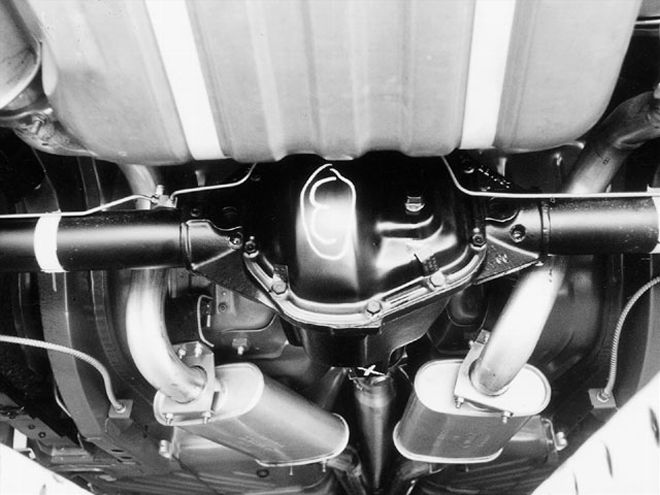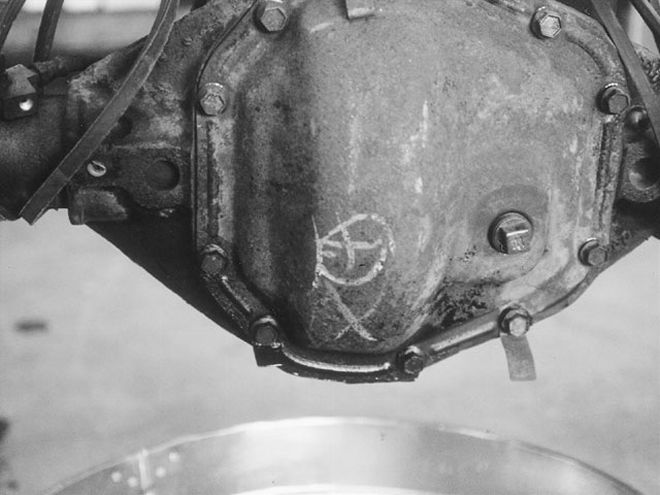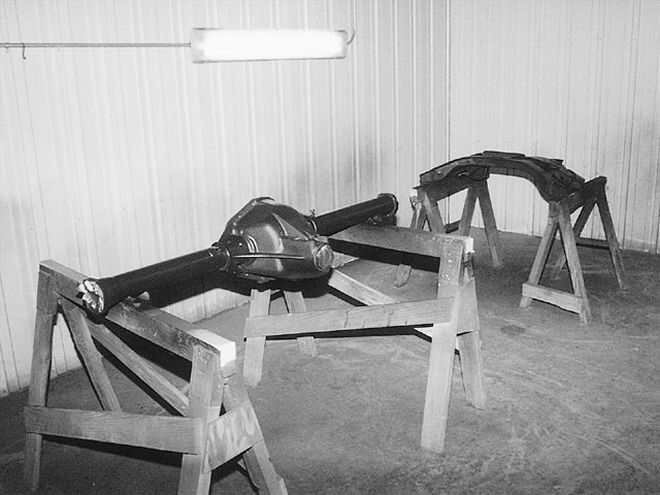

This is the second installment in a series of articles on complete concours restoration, courtesy Roger Gibson Restorations, Mr. Norm's Sport Club, and Jim Bordanis. The subject vehicle in the series is a '70 Hemi 'Cuda coupe, which Mr. Gibson is presently totally restoring to originality. The techniques, described in Gibson's own words, will apply to any project of this nature. For this special Hemi Mopar issue, Roger will share some of his knowledge with us in the proper detailing of a Dana rear.
The Mighty Dana 60: An Overview
By the time the Street Hemi made its debut in 1966, Chrysler knew if they were to install the monster race-bred mill in front of the A833 four-speed transmission, they had better back it up with a super heavy-duty rear end capable of withstanding copious amounts of torque. They also knew that many of their customers that ordered this combo would inevitably put in some "track time" with their new steeds. The answer? The bulletproof Dana 60.
 Once you clean off the axle assembly, many markings become evident, depending on the year, axle ratio, and body style. On the rear cover you may find an X or maybe a pair of Xs with a circle around one (Fig. 2A). We have noticed what appears to be the number 3 on the differential housing cover on some '71s; we later determined that this is actually the letter E and denotes the usage on E-Body cars. If you look under the Dana centersection, you may find more markings such as Xs and/or paint daubs (Fig. 2B). Once you remove the pinion snubber, you may have some more marks to document as well. Another thing to cover is the plastic plug (what we call the Dana plug), which is on the left (driver) side area of the cast differential housing facing the rear of the car. Typically, we have seen these in blue and red. It's a plastic plug and usually has the manufacturer's name on it.
Once you clean off the axle assembly, many markings become evident, depending on the year, axle ratio, and body style. On the rear cover you may find an X or maybe a pair of Xs with a circle around one (Fig. 2A). We have noticed what appears to be the number 3 on the differential housing cover on some '71s; we later determined that this is actually the letter E and denotes the usage on E-Body cars. If you look under the Dana centersection, you may find more markings such as Xs and/or paint daubs (Fig. 2B). Once you remove the pinion snubber, you may have some more marks to document as well. Another thing to cover is the plastic plug (what we call the Dana plug), which is on the left (driver) side area of the cast differential housing facing the rear of the car. Typically, we have seen these in blue and red. It's a plastic plug and usually has the manufacturer's name on it.
Not all Hemi cars had the truck-breed Dana rear as standard equipment. TorqueFlite automatic-equipped Hemi (and 440) vehicles came with the Chrysler-built 8 3/4 rear as standard equipment, with the option of a 4.10:1 Dana ('69-'71) just a pencil mark away on the order sheet. The four-speed Street Hemi cars (as well as '68-'72 440 four-speed models) received the Dana 60 as standard equipment, actually as a necessary option that you had to take and pay for. One exception was the '69 1/2 M-code 440-6 Road Runners and Superbees, which came only with a Dana 60 stuffed with 4.10:1 gears, regardless of the transmission type. There were optional dealer-installed ratios as well. This article will deal only with what was available and installed from the factory, and the accompanying chart (Fig. 1) will explain the various Dana codes used throughout the years.
Details On Restoring A Dana Assembly
Regardless of type, I remove the differential and springs as an assembly. The differential is carefully steam cleaned or pressure-washed and photographed. Typically, these differentials have inspection marks, tags, stampings, and so on to document and color match. For a concours restoration, all of these things will need to be duplicated later, so I go over the rear to look for clues on the brakes, housing, pumpkin and peripheral parts, and document details as carefully as possible (Fig. 2).
Once done, the rear is disassembled and I place all the hardware and parts into boxes and mark them. I have a box for the leaf spring removal, separate boxes for the left and right brake assemblies, and another one for the rest of the external housing. The whole time, I still photograph and make notes. I also check the date code of the differential, which is stamped into the tube (Fig. 3). With the differential now disassembled, we send it to RediStrip, along with the rear cover, driveshaft, yoke, pinion snubber, and brake backing plates for derusting. While these parts are getting derusted, we clean and inspect the internal differential components and rebuild or replace the mechanical parts as needed.
Once we have the housing back, the first thing we do is paint it. The factory never applied primer to the assembly prior to painting, which resulted in flaking after the first few years. To prevent this, we first apply black primer to the axle tube area; dry it by resting on the spring perches. All of the original Danas we have seen have a fairly glossy finish, so to duplicate it, we use acrylic enamel as the factory did originally.
 We use black primer for a number of reasons. One is that after 30-plus years of service, most of the axles' tubes are rusty and pitted. We prime the tubes fairly heavy to fill the pits. We then sand the area and reprime as necessary to smooth any pitting. Originally, the edge of the flange to about 3 inches inward was capped off and didn't get any paint. This is usually the worst area on the tube for rust and pitting. To repair the pitting, we prime and paint up to the backside of the flange and mask off the edges and the face. The cast-iron centersection receives only a light coat of primer for the paint to adhere to. You do not want to lose any of the original porosity with too much paint here. The reason for using primer in black is to safeguard against any of the inevitable chips and scratches that can occur when bolting the U-bolts back on. You do not want to see gray or red primer show through if this happens. The internals are reinstalled and the back cover is also primered.
We use black primer for a number of reasons. One is that after 30-plus years of service, most of the axles' tubes are rusty and pitted. We prime the tubes fairly heavy to fill the pits. We then sand the area and reprime as necessary to smooth any pitting. Originally, the edge of the flange to about 3 inches inward was capped off and didn't get any paint. This is usually the worst area on the tube for rust and pitting. To repair the pitting, we prime and paint up to the backside of the flange and mask off the edges and the face. The cast-iron centersection receives only a light coat of primer for the paint to adhere to. You do not want to lose any of the original porosity with too much paint here. The reason for using primer in black is to safeguard against any of the inevitable chips and scratches that can occur when bolting the U-bolts back on. You do not want to see gray or red primer show through if this happens. The internals are reinstalled and the back cover is also primered.
We are ready to reassemble all the components. First the gears, axles, and brake backing plates are attached to the housing using new seals and gaskets. Using the pictures we took earlier as a guide, we can reapply the markings with acrylic enamel paint that we color-matched during the documenting process. We have stamps made of the original number stamping and apply that with the proper color acrylic enamel. The font style remained consistent through the years. The axle strap is installed as well, and I finish installing the brake lines, hoses, brakes, and paper and metal tags (Fig. 8). Attention to detail is a major part of any component or subassembly rebuild; once back in the car, you should have an original-looking differential still capable of handling all of the power the Chrysler engineers could throw at it!
Remember, the little things make a restoration exceptional. If the attention to detail and correctness are used throughout the restoration on every part of the car, whether you think anyone will ever see it or not, your car can compete with the nation's best forever, because correct is correct, today or 10 years from now.
Stay tuned as we continue to apply Roger Gibson's restoration philosophy to the "Save The Fish" 'Cuda in upcoming issues.
Remember These Points
Notes
The Axle Code number above will appear on the axle (stamp) and the broadcast sheet. It will also appear on the fender tag of '69-'72 vehicles assembled at the Lynch Road Assembly Plant. The code is the last three digits of the part number, which is printed on the paper strap on the axle. The paper axle straps were used from 1968-'71.
* The exception is the '6911/42 M-code (A12 Package) cars. "999" will appear on the broadcast sheet and fender tag but "108"- the last three digits of the part number, is printed on the paper strap and ink-stamped on the axle tube. The '67-'68 Super Stock packages are not included in the above chart.
A32 - (1969-'70) - Super Performance Axle Package: 4.10:1 Dana with automatic trans.
A33 - (1969-'72) - Track Pak: 3.54:1 Dana with four-speed trans.
A34 - (1969-'70) - Super Track Pak: 4.10:1 Dana with four-speed trans.
A34 - (1971) - Super Track Pak: 4.10:1 Dana with four-speed or automatic trans.
Dana 60 Axle Usage and CodesModelAxleBodyAxleDrumNotes/AxleYearCodeStyleRatioSizePackage1966194B3.54:11"